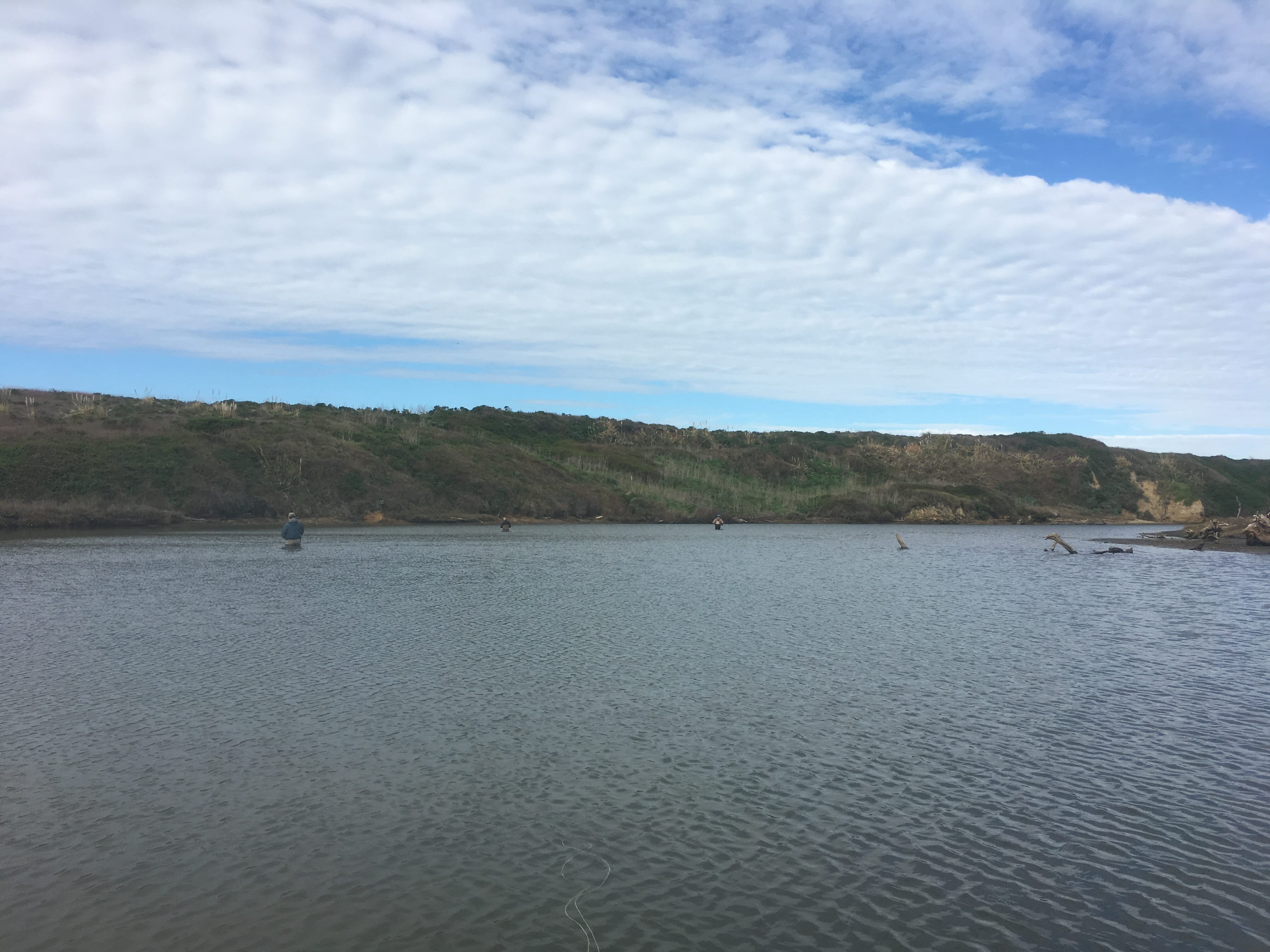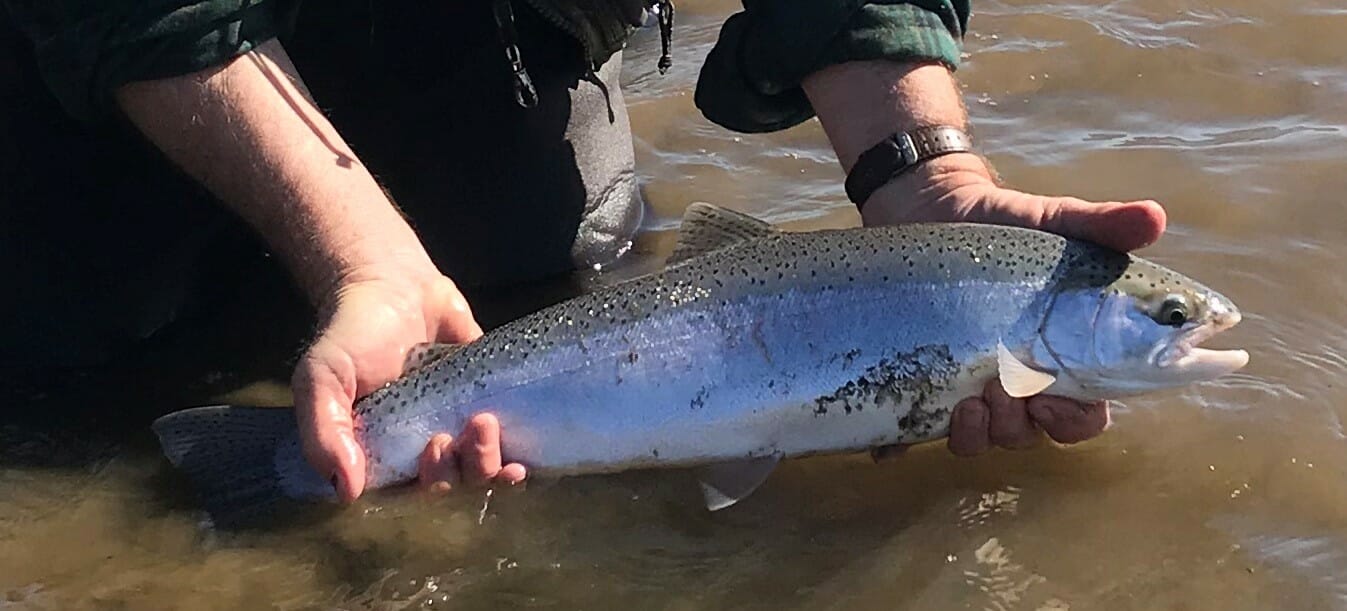TU’s Brian Johnson, the Steelhead Whisperer, and Scott Yates at the end of the steelhead season on California’s central coast.
By Sam Davidson
The steelhead season ended almost exactly the way it began. I spent both the opener and the close at the same place, with the same crew. With the same results. Which is to say, not much.
The winter steelhead fishing season is short on California’s central coast. Few streams offer consistent angling opportunities, especially in years like this, when we received virtually no rain from December through February. Most coastal rivers opened to the ocean rarely, if at all, giving local runs of steelhead few opportunities to enter fresh water.
On those rare days when conditions align with state regulations for these waters, you have to take advantage.

The early morning crew.
This season, I did. At least by my own, limited standards. Especially if you consider showing up and casting doggedly for entire days, with little action to show for it, to be “taking advantage.”
There is one creek in these parts that is consistently fishable whether winter is profligate or miserly. And that’s where I bookended the steelhead season.
This drainage is remarkable for a couple of reasons. First, despite its relatively small size it is one of the most productive habitats for steelhead south of San Francisco. Juvenile O. mykiss grow rapidly in the estuary, gorging on scuds. Rotund, 9-inch long young-of-the-year are not uncommon here.
Second, this water is guarded by a small, tight fraternity of local anglers who make sure that visitors observe both the formal fishing regulations and an informal code of conduct.

The Steelhead Whisperer and Scott Yates on the water which shall not be named.
A recent incident illustrates their commitment to this duty. On another day I happened to arrive as an angler was being chided by a state parks law enforcement officer. The visitor, apparently, imagined that his cigarette butts were an enhancement to the landscape. The locals had exchanged no words directly with this cretin, but somehow the officer was alerted and the individual, being deemed not sufficiently apologetic, was escorted from the premises.
Thus, it has been no small comfort to me that one of the real masters of this water, the Steelhead Whisperer, has allowed me to tag along on some of his outings there. And while I couldn’t avoid committing a peccadillo or three over several visits to this beautiful but taxing spot this season, I haven’t gotten disinvited back. Yet.
My uncertain status on this water was on my mind on March 7, the final day of the season. I had visions of a display of competence sufficient to keep me on the team—or at least on the sideline. These visions tormented me on the two-hour drive north, which began in the dark and ended as dawn sidled over the eastern horizon.
The Steelhead Whisperer, of course, was already on the water and had gotten a grab. The other regulars were there, too, fan casting from their waist-deep stances, the outgoing tide coaxing a gentle current in the otherwise placid water.

The biggest fish of the day takes some line from the Steelhead Whisperer.
It was a lovely, peaceful setting. Then I waded in.
On a recommendation from the Steelhead Whisperer I had re-rigged my steelhead gear for the conditions. Floating line, long leader. It took me a few casts to get the hang of the new set-up. Well, maybe more than a few. I am sorry to say several volleys of imprecations issued from my vicinity.
The anglers around me muttered and, pretending to be covering water, gave me enough clearance for an NIH quarantine.
At length I felt the telltale resistance. An 8-inch juvenile swam circles around me and launched repeatedly from the water. I said a prayer of thanks as I released the silvery shadow, that went something like this:
Thank you, glorious future steelhead, for saving me from another skunking. Now off you go, and please pay me a visit when you grow up—so the local boys will tolerate my presence.

The only adult.
Around mid-morning there arrived a visiting angler from Montana, a rangy package of fishing energy known as Scott Yates. Scott is the co-director of Trout Unlimited’s Western Water and Habitat Program. The Steelhead Whisperer works under this program, and has completed groundbreaking habitat restoration and streamflow enhancement projects in this and other nearby watersheds.
Scott fishes like he works: harder than anyone else. He has a booming voice and laugh and a wit to match. His reputation for maniacal approach hikes to access off-the-beaten path fishing waters is well earned.
The approach to this water takes about five minutes and offers no such challenges, but that didn’t seem to matter to Scott. He pulled up on the bank, smiled, and said, “This place is so cool.”
Scott was toting an 8-wt switch rod, which he had just used for two days on the Gualala and Garcia up north. But that’s overkill on this water. The Steelhead Whisperer had brought an extra 6-wt for him to use. Scott hefted the Loomis GLX appreciatively, accepted one of the Whisperer’s stubby flies tied specifically for this place, and stepped through billows of tiny scuds in the shallows into the deeper, olive-tinted water.

Plying the lower end of the estuary.
And then he began to cast. I watched in awe.
Scott’s casting style is unique. He contorts his body and rifles powerful casts with pinpoint accuracy. He looks like Clayton Kershaw uncorking a wicked heater.
Scott catches fish—big fish—wherever he wets a line. But even he raised no adult steelhead that day. Only the Steelhead Whisperer, of all the talent there assembled, brought one, a slightly colored 4 or 5 pound fish, to hand.
The rest of us, including TU’s California Director, Brian Johnson, who checked off the final day of the season on his steelhead card with a late afternoon appearance, had to content ourselves with a handful of dynamic juveniles in the 10- to 14-inch range.
So it goes. “You pound the water,” as the Steelhead Whisperer likes to say, “and maybe you run into a few fish.”
At length the sun declined behind the bluffs at the mouth of the estuary and evening came on. The TU crew gathered in the bank. I had been there the whole day, and the Steelhead Whisperer began at first light. Scott raved, “You guys put in twelve hours today!” with only a hint of envy. “And there’s the title of your next post,” he said to me.
The Steelhead Whisperer and I lingered in the gloaming after Scott and Brian had left, savoring a full day of fishing on the final day of the season. Suddenly we heard a solid ploop, and in the last lumens of light saw the concentric rings on the water. And just like that, back into the water we went, to pound it a few more times.
Sam Davidson is TU’s Communications Director for California and Oregon. He lives and works in the Carmel River watershed, the focus of an intensive steelhead recovery effort.



